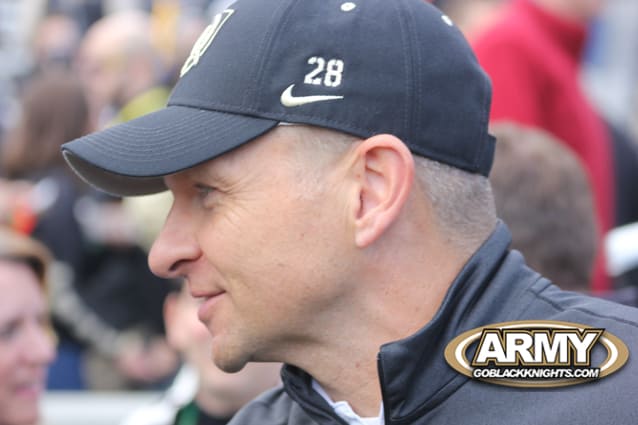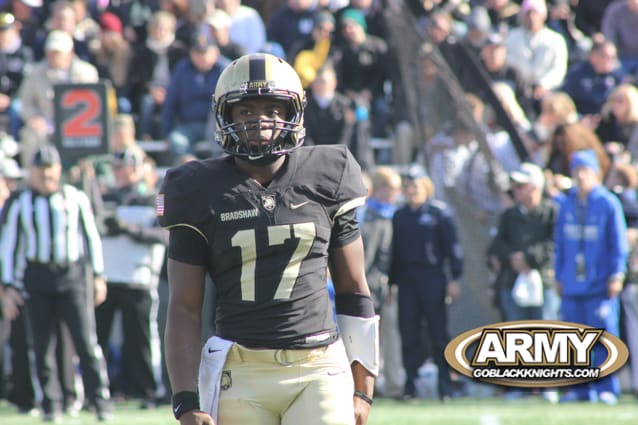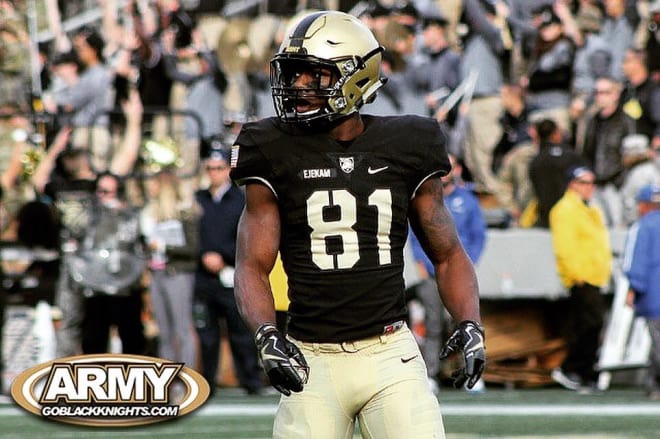FREE GBK UPDATE: Passing in the Triple Option Offense

Don’t miss out our GBK exclusive football recruiting coverage. CLICK HERE FOR 15-DAY FREE TRIAL TO GBK

Most of us are reasonably familiar with Coach Head Coach Jeff Monken’s philosophy on passing. In a press conference following the game against Buffalo back in 2014, Monken made his thoughts known to Army West Point football fans:
"I would like to not feature the passing game at all. We are a running team. I like to run the ball,” he stated. “We will throw it when we need to and when the defense plays so heavily on the run and is making it difficult, that is when we will have the opportunity to pass the ball.”
No doubt, Monken’s philosophy is shared by the other coaches who run the triple option in the FBS. Consider, for example, the following rankings in Passing Offense last season:
128th - Army West Point 74.4 Yds and 9.46 Attempts/game
125th - Navy averaged 128.1 Yds and 11.3 Attempts/Gm
124th - Georgia Tech averaged 129.2 Yds and 12.31 Attempts/Gm
123d - Air Forces averaged 134.8 Yds and 11.54 Attempts/Gm
No teams in the FBS had fewer pass attempts per game than the 4 triple option teams listed above. Tulane and New Mexico finished 126th and 127th in yards per game but both threw the ball more often than any of the above teams.
Objective - Make Opponents Pay for Playing Run
Although none of the triple option coaches likes to pass often, the second half of Monken’s statement tells us when they will pass. It doesn’t follow always follow conventional football wisdom about throwing on passing downs. In fact, Monken was about as likely to call a pass on first down and ten as he was on third down and long.
Lou Cella, a well known teacher of triple option techniques provides another key to explain the strategy of the passing game in the triple option. His first core value for triple option football is “Throw vertical for touchdowns.” Basically, the strategy is to pass it over the defender when they come up to cover the run. Virtually all the pass plays are play action passes and the goal is to pick up lots of yards when passing.
What do the statistics tell us about that core value? It turns out that the four teams mentioned above, ranked 1 through 4 in yards per completion and 3 of them ranked in the top 4 in yards per attempt in 2016; so all four go for more explosive pass plays.

#1 Air Force averaged 25.76 yards per completion and 11.68 yards per attempt.
#2 Georgia Tech averaged 20.23 yards per completion and 10.49 yards per attempt.
#3 Navy averaged 19.29 yards per completion and 11.35 yards per attempt.
#4 Army West Point averaged 17.86 yards per completion but just 7.86 yards per attempt (about 33d in the FBS)
Completion Percentages are not as Important
One might think that it’s important for triple option teams to complete a high percentage of their pass attempts, but that doesn’t appear to be the case. The best of our four triple option teams in completion percentage was Navy with a 58.9% completion rate. That ranked them 59th in the FBS. The next best was Georgia Tech with a 51.9% completion rate, which ranked them 116th in the FBS. Air Force and Army West Point finished 126th and 127th respecively, with less than 46% completion rates for each.
Passing Efficiency - an Interesting and Informative Statistic
In previous articles we’ve mentioned Passing Efficiency as a good indicator of what Army West Point should be trying to accomplish with its passing game, but the statistic has its flaws. The major problem is that it attempts to combine a number of different factors into a single number, and that tends to obscure what is actually being measured.
Basically Passing Efficiency measures the relative success that a passer achieves per attempt in 4 different indicators of success: Completion percentage, Yards per attempt, Touchdowns per attempt, and Interceptions per attempt. The weight assigned to each of these factors is somewhat arbitrary, which makes it difficult to understand exactly what is being measured by looking only at the final calculation. Complicating this for the average fan is that the formula used by the NFL is different than the one used by the NCAA, and NFL ratings are usually lower than NCAA ratings for the same set of statistics.
Despite it’s shortcomings, Passing Efficiency is a fairly good measure of success in what triple option teams are trying to accomplish with their passing games, and when combined with a good rushing offense, high ratings in Passing Efficiency tend to correlate fairly well with overall success. Of our 4 triple option teams, 3 finished in the top 20 in Team Passing Efficiency.

Navy (9-5) ranked 7th with an efficiency rating of 164.17. Perhaps even more significant was the fact that the Middies went 9-3 with Will Worth, who had a Passing Efficiency rating of 179.27, and dropped to 0-2 with Zach Abey, who had an efficiency rating of 128.19.
Air Force (10-3) ended the season ranked 8th in Passing Efficiency with a rating of 163.58, showing how little their 45% completion rate effected passing efficiency. The keys to their high rating were their top ranking in yards per completion and a high touchdown to interception ratio of 14 to 8. Nate Romine had a good Passing Efficiency Rating of 158.61, but Arion Worthman was even better with a rating of 200.16. Worthman’s better passing probably contributed to AFA’s greater success in the latter half of the season.
Georgia Tech (9-4) finished 16th in Passing Efficiency with a rating of 153.59. As with AFA, their low completion percentage was compensated for by their high yards per completion and a good ratio of 9 TDs to 4 INTs.
Army West Point was the poor relation in this group with a Passing Efficiency rating of 110.84, which ranked 117th in the FBS. Army’s completion percentage was the lowest of all 4 teams, but even more significant was that Army had 11 Interceptions and only 7 Passing TDs.
The significance of Passing Efficiency on the success of Army football in 2016 is more discernable when we compare Efficiency ratings from winning games to ratings in losing games.
| OPPONENT | EFFICIENCY |
|---|---|
|
Temple |
65.20 |
|
Rice |
159.07 |
|
UTEP |
311.45 |
|
Lafayette |
216.58 |
|
Wake Forest |
216.44 |
|
Morgan State |
138.6 |
|
Navy |
73.5 (Navy’s Passing Efficiency was 94.8) |
|
North Texas (HOD Bowl) |
161.3 |
| OPPONENT | EFFICIENCY |
|---|---|
|
Buffalo |
60.32 |
|
Duke |
46.51 |
|
North Texas (at Michie) |
32.84 |
|
Air Force |
70.97 (AFA’s Passing Efficiency was 285.3) |
|
Notre Dame |
13.65 |

Cause or Effect?
While the correlation between passing efficiency and wins is apparent from the above comparisons, it’s not at all clear that poor passing efficiency was a significant contributory cause of losing or if the low passing efficiency ratings came as a result of trying to come from behind in a losing effort.
The regular season North Texas game provides an interesting study. Ahmad Bradshaw threw 4 interceptions in that game, three of which came in the 4th quarter when Army fell behind 28 to 18. Based on that information alone, one might assume that the poor efficiency rating was caused by Monken going into desperation mode and passing to catch up, but was that really the case?
In the first series of downs in the fourth quarter, Bradshaw completed 2 of 2 attempts for 40 yards (efficiency rating of 268), but Mendenhall fumbled the ball after a 31 yard completion, ending a good drive. In the second series, Bradshaw went to the air, attempting to pass on all 5 downs. He completed 2 of 5 for 19 yards and ended the series with an Interception (efficiency rating of 31.9). He continued the passing game on the next series completing 2 of 4 for 16 yards and ended with another interception (efficiency rating of 33.6). On the final drive, he attempted 4 passes in 5 downs completing none of them and finishing with an interception (efficiency rating of -50). Clearly, Monken abandoned his normal passing strategy in a desperation attempt to catch up in the 4th quarter, and the passing efficiency rating for that quarter alone was 42.0; but the efficiency rating for the first 3 quarters was even worse. In the first three quarters Army completed just 1 pass of 6 attempts for 19 yards with 1 interception for an efficiency rating of 9.93 for the first three quarters of the game. One could argue that Army’s poor passing game in the first three quarters was as much responsible for the scoring deficit as the deficit was in creating a bad passing situation at the end of the game.
An Area for Improvement
In our article on goals for the spring practice, one of the items on our list was “Improve the Passing Game,” and Brent Davis included that as one of his objectives in an interview with GBK as well. We really can’t compare performances in spring practice with actual season game conditions, but we wanted to hear what Davis had to say about progress made in this area this spring. We will provide you with our findings in our Friday article.